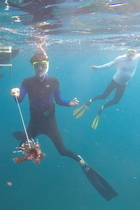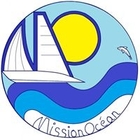Mission Ocean: Turning Problem Predators into Reef Resources

It was a hot, dusty day in Bequia, the second largest island in the Grenadines. We were sweating our way back to the dinghy dock with bags of fresh mangoes and vegetables, when we spotted what looked like a bed sheet with a lionfish painted on it hanging from the terrace roof of a cafe.
A small poster next to it detailed a conference program for that afternoon, including how to cook and prepare a lionfish. Interested, we whizzed back to Contigo to deposit our groceries, and half an hour later were seated at the bar, Carib's in hand and notebooks at the ready.
We first became really aware of the lionfish problem in the Caribbean when diving in Dominica just after Hurricane Maria. The dive shop owner came with us, armed with a trident and a big white bucket; he proceeded to fill it with around 25 of these eerily beautiful, apparently fearless fish, which made no effort to escape his spear.
He explained to us that lionfish had been introduced to the Caribbean from Asia by humans, probably via the US aquarium trade, and that they had no natural predators here.
Lionfish on a reef in Martinique
It had recently been made legal to hunt lionfish with bottles in Dominica, as the reefs had become overrun with them since the hurricanes of 2017. They have been observed from North Carolina to South America, throughout the Caribbean and in the Gulf of Mexico. Feasting primarily on fish eggs and larvae, they are decimating indigenous populations, wiping out fish stocks and breeding like crazy (lionfish can reproduce every 4 days, with a single couple spawning up to 2 million eggs a year!)
Hunting lionfish with bottles in Dominica
The conference in Bequia turned out to be run by Reef Save, a non-profit from the US, and was aimed at encouraging local people to hunt, prepare and eat lionfish, or to sell it to restuarants and resorts. Lionfish has a particularly meaty, tasty flesh, but you have to be motivated to get to it. Protected by nasty spines that cause extreme swelling, strong gloves and a bit of knowledge are essential to hold, skin and filet them.
Together with a bunch of burly fishermen throwing back local rum, we watched videos and listened to the explanations of the Reef Save team, who have been working on techniques to catch lionfish for the last two years. They were in Bequia to carry out fifteen-day trials on a low-tech purse trap, plans for which, once approved, would be made available to all online. The trap is designed to be made using items which can easily be sourced or made pretty much anywhere in the world.

The Reef Save team and the lionfish trap
The one on show in Bequia consisted of a vertical piece of trellis, some plastic pipes, fishing net, line and a buoy. Using cameras and many hours of diving to gather data, Reef Save had observed that lionfish were drawn to vertical objets, where they congregate. They also exhibit site fidelity, meaning that once they like a spot, they tend to stay there.
The vertical trellis acts as a sort of fish magnet, especially when laid on a featureless sandy seabed ; the rest of the trap closes like a book around the trellis, from which the predator-less lionfish made little effort to escape. A net full of up to 30 lionfish can then be drawn up into a boat, and preparation of these spiny delicacies can begin.

The beautiful bay in Bequia
We were impressed with Reef Save's low-tech plans, and caught up with the team later for a drink. They explained to us that their wider goal was to turn problems on reefs into resources, and that the lionfish project was a good example of this. Local fishing communities had shown great enthusiasm for the traps, and a demand for the meaty filets was growing in luxury resorts on the island; we had even seen lionfish sashimi on a hotel menu in Saint Lucia.
As well as raising awareness, the trials in Bequia aimed to eliminate any potential by-catch (which would be counter-productive), and to test the movement and resilience of the traps, so as to avoid them drifiting away and contributing yet more to the thousands of ghost nets floating around the seas, estimated to make up around 10% of ocean plastic pollution.
Henrique diving for lionfish
If you would like to find out more, or learn to prepare lionfish filets for your guests, Reef Save's website (www.reefsave.org) and YouTube videos are quite insightful. The non-profit is also on the lookout for volunteers to dive on their existing traps to check their condition, or even to help with a bit of data analysis.
We have since been inspired to hunt lionfish ourselves, and have found that it is legal and encouraged almost anywhere (including many no-fish zones) provided that you are not diving with bottles. Henrique's most successful catch took place at anchor underneath our boat, spearing 6 juveniles on a driftwood branch at a depth of 10m.
So chefs, freedivers and data analysers, take note of local fishing laws, have a look at Reef Save's work in your next coffee break and then give lionfish sashimi a go.


Post your comment
You cannot post comments until you have logged in.
Login to post a commentComments
No one has commented on this page yet.
RSS feed for comments on this page | RSS feed for all comments